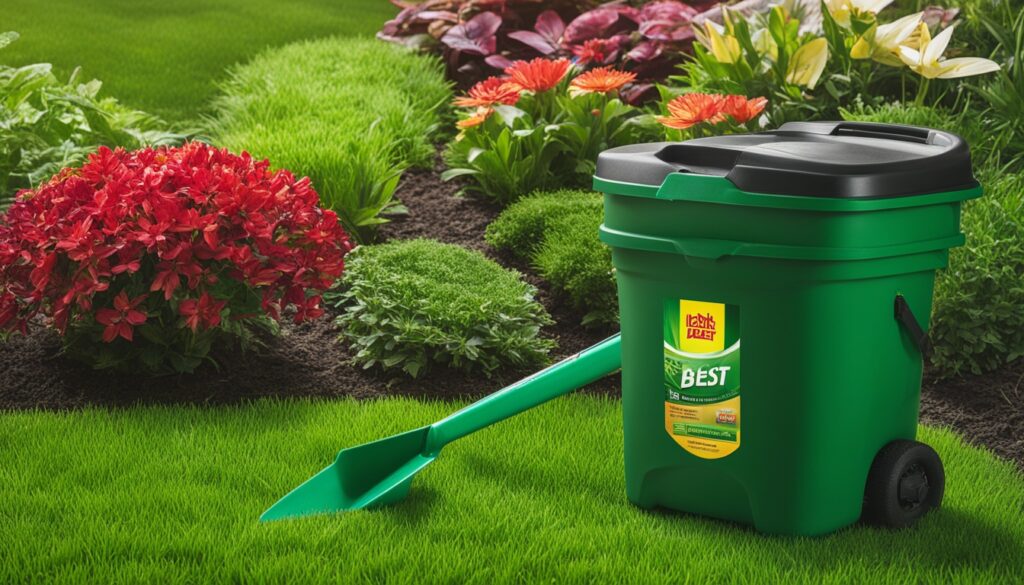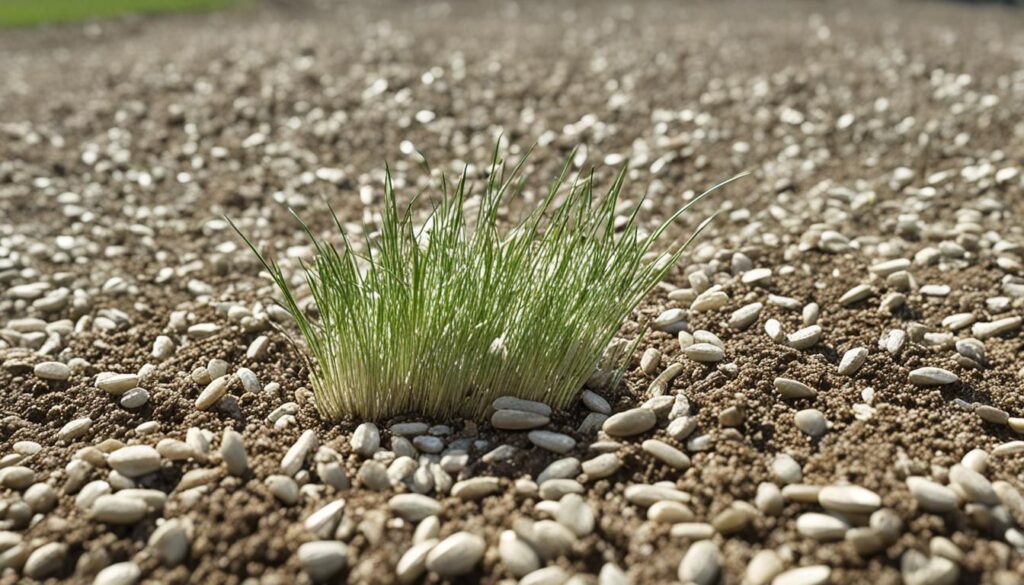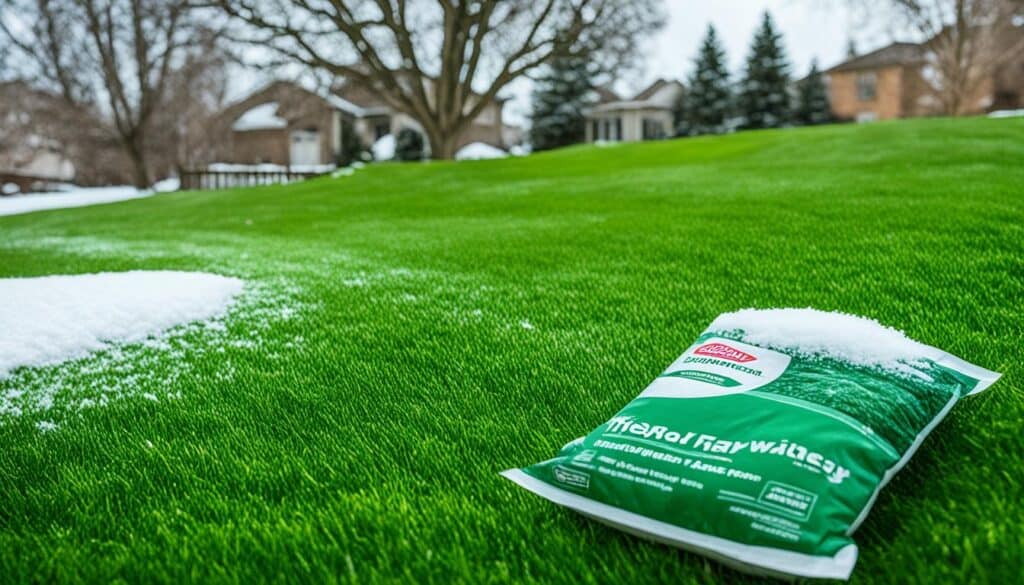Did you know the right fertilizer can cut your lawn’s water use by up to 30%? This fact shows how important proper fertilizing is for a lush lawn. Whether you’re a pro or a beginner, knowing the best fertilizer for thick, green grass is crucial for a perfect yard.
Your lawn’s health needs a balance of nutrients, especially nitrogen, phosphorus, and potassium (NPK). These elements are vital for strong grass growth. For example, a 10-10-10 fertilizer gives equal parts of each nutrient. But, your lawn might need different amounts based on its type and soil.
When to fertilize is just as important as what to use. Cool-season grasses like fescue and Kentucky bluegrass do well with feedings in early spring and fall. Warm-season grasses like bermuda and zoysia need more often, especially when they’re growing fast. Knowing your grass type helps you plan the best lawn care schedule and give your turf the right nutrients at the right time.
Choosing between organic and synthetic fertilizers, and slow-release and quick-release types, affects your lawn’s health and look. Quick options work fast, but slow-release ones feed your lawn over time. Pick what fits your lawn care goals and your grass’s needs.
To get the most from fertilizing, think about your soil’s pH and how you apply it. Even spreading it out is key, and applying to dry grass and watering later prevents damage. By doing these things and picking the right product, you’ll be on your way to a lush, green lawn.
Key Takeaways
- Proper fertilization can reduce lawn water needs by up to 30%
- NPK ratios on fertilizer packages indicate nutrient content
- Fertilization timing varies for cool-season and warm-season grasses
- Choose between organic/synthetic and slow-release/quick-release fertilizers
- Proper application techniques are crucial for optimal results
- Consider soil pH and grass type when selecting fertilizer
- Regular maintenance is key to a thick, green lawn
Understanding Lawn Fertilizer Basics
Fertilizing your lawn is crucial for lush, green grass. The best time for landscaping and lawn care is usually early spring. Knowing about fertilizer basics helps you choose the right lawn care options and when to apply them.
What is NPK and why it matters
NPK means Nitrogen, Phosphorus, and Potassium. These nutrients are key for healthy grass. The NPK ratio on fertilizer labels tells you the percentage of each nutrient.
| Nutrient | Role | Ideal Content |
|---|---|---|
| Nitrogen (N) | Promotes growth and green color | 10-20% (season dependent) |
| Phosphorus (P) | Supports root development | 0-4% (often restricted) |
| Potassium (K) | Enhances overall grass health | 0-8% (varies by season) |
The role of nitrogen in grass growth
Nitrogen is key for fast growth and keeping grass green. A 20% nitrogen content in a 50-pound bag means there’s 10 pounds of nitrogen. Some fertilizers release nutrients slowly over 6-8 weeks, while others work faster.
Importance of soil pH for nutrient absorption
Soil pH impacts how well grass takes in nutrients. Most grasses do best in a pH of 6.0 to 7.0. Testing your soil regularly helps find out the pH level and nutrient gaps. This ensures you pick the best fertilizer during the best lawn care times.
Types of Lawn Fertilizers for Optimal Growth
Choosing the right fertilizer is key to a lush, green lawn. Your selection impacts lawn care operating hours and the preferred time for yard work. Let’s explore different fertilizer types to help you make an informed choice.
Organic vs. Synthetic Fertilizers
Organic fertilizers come from natural sources and release nutrients slowly. They improve soil health over time. Synthetic fertilizers offer quick results with precise nutrient ratios. Your choice affects lawn care time restrictions.
Slow-release vs. Quick-release Formulas
Slow-release fertilizers feed your lawn gradually, reducing burn risk. They need fewer applications, easing your yard work schedule. Quick-release types give fast results but require more frequent use.
Granular vs. Liquid Fertilizers
Granular fertilizers are easy to spread and often slow-release. They’re great for picking the right fertilizer for your. Liquid types offer quick absorption and even coverage. Your choice impacts application time and frequency.
| Fertilizer Type | Release Speed | Application Frequency | Best For |
|---|---|---|---|
| Organic | Slow | Less frequent | Long-term soil health |
| Synthetic | Quick | More frequent | Immediate results |
| Slow-release | Gradual | Every 6-8 weeks | Consistent growth |
| Quick-release | Rapid | Every 3-4 weeks | Fast green-up |
| Granular | Varies | Depends on type | Easy spreading |
| Liquid | Quick | Every 2-3 weeks | Even coverage |
Remember, timing is crucial when mowing after applying. Your lawn care routine should align with the fertilizer type you choose. Pick a fertilizer that fits your lawn needs and your preferred yard work schedule.
What Fertilizer Makes Grass Thicker and Greener
Choosing the right fertilizer is crucial for a lush, green lawn. Nitrogen-rich formulas help make grass thicker and greener. Look for products with a higher first number in the NPK ratio, like 30-0-4 or 34-0-4. These numbers show the nitrogen, phosphorus, and potassium levels in the fertilizer.
Slow-release nitrogen fertilizers, like Milorganite, work well for a long time. They feed your lawn slowly, reducing the risk of burning and helping it grow steadily. For an extra green boost, consider iron supplements such as Ironite. These improve color without making the grass grow too much.

Timing is important when planning your lawn care. The best time for landscaping and fertilizing depends on your grass type. Cool-season grasses do well with fertilizer in early spring and fall. Warm-season grasses need fertilization in late spring and summer.
Early morning is the best time to start lawn care. This lets the fertilizer soak in before the day gets hot. Watering your lawn after applying fertilizer helps nutrients reach the roots.
For new lawns or overseeding, use a starter fertilizer with a balanced NPK ratio like 22-23-4. This gives your lawn the nutrients it needs for strong roots and growth. Remember, regular fertilization, proper watering, and consistent mowing are key to a healthy lawn.
“A healthy lawn is the result of consistent care and the right nutrients. Tailor your fertilizer choice to your grass type and soil needs for the best results.”
Timing and Application Techniques for Best Results
Getting the timing and application right is crucial for a lush, green lawn. The best time to start lawn care depends on your grass type and the climate in your area. Let’s look at the best ways to fertilize different grasses and how to apply it right.
Seasonal Fertilizing Schedule for Cool-Season Grasses
Cool-season grasses do well in early spring and fall. You should fertilize once between February and April when the grass starts to green up. Then, do a second application 6 to 8 weeks later, from April to June.
A summer feeding is optional, but a fall application between August and November is key for getting ready for winter.

Fertilizing Warm-Season Grasses
Warm-season grasses need fertilizing every 4-8 weeks during the summer. Start when the grass greens up in late spring and keep going until early fall. Don’t fertilize too late to avoid damage in winter.
Proper Application Methods
To prevent lawn damage, keep these tips in mind:
- Apply fertilizer when the grass is dry
- Water well after applying
- Use a spreader for even spreading
- Spread it in a crisscross pattern for full coverage
- Don’t fertilize during drought or extreme heat
Lawn care hours can change with the seasons. Plan your fertilizing based on these hours and your area’s needs. Always follow the product’s instructions for how much and when to apply for the best results and a healthy lawn.
| Grass Type | Fertilization Frequency | Best Time to Fertilize |
|---|---|---|
| Cool-Season | 2-4 times per year | Early spring and fall |
| Warm-Season | Every 4-8 weeks | Late spring to early fall |
Conclusion
Choosing the right fertilizer is crucial for a lush, vibrant lawn. It’s important to know what makes grass thicker and greener. The NPK method, with its 20-20-10 ratio, gives essential nutrients for growth, root health, and fighting diseases. Fertilize your lawn at least twice a year, once in the season for the best results.
Keep up with regular soil tests and fertilizing. Spring is a great time to start, helping your grass grow strong and deep roots. Proper fertilization leads to a thick, lush lawn that fights weeds, pests, and stress better.
Consistency is key when it comes to landscaping. Start with spring fertilization for long-term lawn health. The right fertilizer for your grass and climate improves your lawn’s look and helps the environment. With these steps, you’re on your way to that thick, green grass you desire.




Thanks for sharing. I read many of your blog posts, cool, your blog is very good. https://accounts.binance.com/register?ref=P9L9FQKY
Thanks , You Can Visit our Blog Section and Subscribe to our Resources . Thanks
Can you be more specific about the content of your article? After reading it, I still have some doubts. Hope you can help me. https://accounts.binance.com/bn/register?ref=UM6SMJM3
Thanks , You Can Visit our Blog Section and Subscribe to our Resources . If you have specific Query you can ask us in Comments Section Thanks
Can you be more specific about the content of your article? After reading it, I still have some doubts. Hope you can help me.